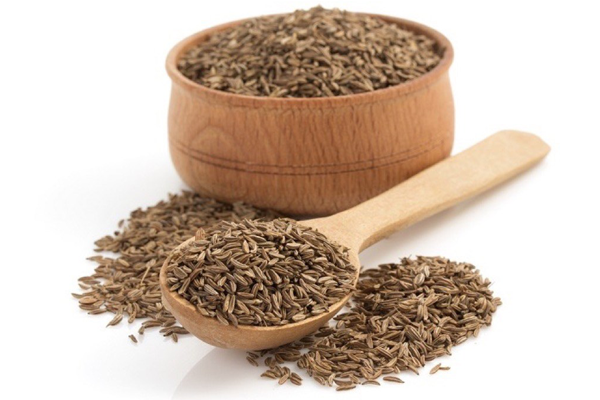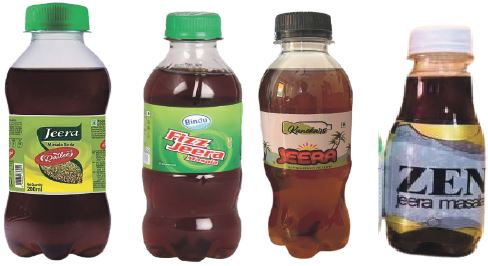All Indian summer thirst quencher…. jeera pani, many local brands in the market.
By Tara Narayan
Jeera pani or jeera paani or `jal jeera’ is Indian summer’s favourite thirst-quenching, digestive beverage, make it at home or buy, buy, buy, only Rs10! There’re half-a-dozen brands in the market…
Not Coco-Cola, Pepsi, Seven-up, Sprite, fanciful Mountain Dew, Fanta, Limca…or any of the so called lunatic energy drinks called Fizz, Red Bull, Monster, etcetera.
THE great summer time marketplace beverages kill is on! The more the heat sizzles, the more people reach out for a bottle of chilled beverage to soothe dry throats. The bottled beverages industry soft and hard is surely on a royal roll, all the way to the bank for sure for we, the people, Indians of all hue, are such suckers for sugar-doped aerated “cold drinks”…who cares if all the sugar and acidic ingredients and a slew of preservatives to beat shelf life, in the short and long run contribute to sick kidneys and livers and of course the big C is on the way?
It’s an evil chain link. The sicker we are the more the pharma market will boom putting out more and more expensive drugs…Rs500 to over a lakh for a cancer drug now (if kind-hearted Health Minister Vishwajeet Rane is your friend you may get it free if you promise him your vote, I’m surprised free medicines have not been linked with voting yet).
But this is about the summer heat and bottled “cold drinks.” Suddenly, out of the blue, my secretary Heena carted in a bag of what we desi people called “jeera pani” or “jira paani. What’s this you’re lugging around? I asked. She said, “For my ma-in-law, she can’t live without a bottle of jeera paani every day!” Can I try one? I asked and she was happy to oblige. I tried and lost whatever is left of my foodie heart – to Bharatdesh’s humble, home-spun “jeera pani” however you want to spell the jeera or paani. The Sawantwadi-made jeera pani was seductively chilled, enticing and full of the flavor of jeera or cumin seeds and yes, it made my stomach happy!
Jeepers creepers, I love jeera pani more than any of the other bottled drinks, for this I can even give up the occasional soda-watery soapy Limca or metallic orange Fanta…the poor drink Rs10 jeera pani, the rich drink aerated corporate drinks of the middlecrust and uppercrust market segment. I’m drinking jeera pani from now onwards in the seventh decade of my autumnal life, I’ve just discovered a wonder drink…jeera pani is so perfectly desi Indian, like say buttermilk or lassi or limbu pani or narial pani or “ghane ka juice” – or the Guju ginger-spiked “gor nu pani.”
Hey, I found at least a dozen brands of jeera pani in the market, sorry, all in pet bottles little and not so little, and I took them home to check them out for more or less salt, more or less suar, more or less jeera flavor, more or less chemical tasting, or more or less natural tasting and what not! Some call themselves “masala jeera pani.” I rather like the home-spun Rs10 ones which do not have too many ingredients in them listed apart from sugar, salt, jeera and water and the fizz of soda which may be mild or not so mild.
I would add the juice of a lemon into a chilled jerra pani on the rocks and sit down and have a slow, long sip in the afternoon when the heat is fierce, or even more fierce after dark when the ceramic floors heat up and ooze heat…even my cotton bedsheet feels hot on the skin and my air-conditioner is perennially conked out. So at midnight I drink chilled jeera paani and dream off to sleep pretending I’m living in Srinagar in the Kashmir valley or Kinnaur in Himachal Pradesh.
DON’T knock jeera, the humble culinary spice of cumin seeds. It is a traditional digestive spice in Indian cooking and features in just about every tempering or phodni of curry or sabzi. Down south India they drink home-made jeera pani daily to cool down and to better digest their meals vegetarian or non-vegetarian. Jeera pani is a household digestive beverage. A friend of mine soaks half-a-teaspoon of cumin seeds and a pinch thymol seeds (ajwain) overnight and boils the water and drinks it daily, says that how she stays as slender as a cucumber (which reminds me, ah, cucumbers but more about them later).
A round-up of jeera pani in the local shops: “Zen jeera masala,” “Bindu fizz jeera masala,” “Jeera masala soda (Dailee)”, “Kanekars Jeera refreshingly healthy” (this is a better quality pet bottle, Rs25, ingredients listed are “carbonated water, sugar, salt, jeera powder” and further details per 100g are “sugar 4.81%, carbohydrate 10.01g, protein 0.1g, fat 0.03g, energy 40.04kcal” and made in Sawantwadi, Maharashtra). There is green capped jeera pani, white-capped jeera pani — so far I’ve taken to Goa’s Madkai-made “Zen jeera masala” (160ml) and “Jeera Masala Soda” (from Tamil Nadu, 200ml bottle, Rs10) – they seem to me to be less salty and sugary, more jeera perhaps! Find one which suits your palate the most. I’m planning to do all kinds of things. Like my buttermilk in jeera pani water and then chill and sip on the rocks…
Actually, the rule of nature is cold will heat you up, hot will cool you down: don’t ask me why! See, drink hot tea and you will feel cool and fine; drink cold anything and you’ll feel hot and more thirsty, especially if your cold is doped with refined with white sugar. Sugar is carcinogenic regardless of where it is in your breads leavened/unleavened, in your drinks hot or cold, in your food cooked or not cooked.
Dump refined sugar as much as you can and see the difference in six months! It’s an industrial product of the food industry which seeks to make a mess of our mind and body, heart and soul, from the inside out and outside in.
Ditto with industrialized salts. Return to good organic jaggery of any kind and natural sea salt or Celtic salt (more or less the same thing, rock salt, black salt, discover them all in lieu of refined white rolling table salt). Also dump refined oils, use freshly squeezed oils economically (oil is linked with heart disease, hence fryum foods no no).
If you’re asking me, no, I haven’t succeeded in dumping too many of the things I’m asking you to dump here for wellbeing long term. I just keep trying to make a clean sweep in bits and pieces here and there – but my kitchen stocks jaggery powder (for making tea), sea salt and Himalayan salt, physically refined coconut, sesame, mustard and olive oil, also desi ghee, all of which I used very economically when required (with the exception of ghee on phulka).
KNOW SOMETHING ABOUT JEERA!

KNOW something about jeera, cumin seeds in English, botanically Cuminum cyminum. They’re seeds of a fruit from the plant family Apiaceae and native to the Irano-Turanian region although India is the largest producer of cumin seeds in the world today (70%). It is a spice highly rated for its digestive properties and therefore used in several cuisines across the world – both as seeds and in ground form. In India we have a combo of “dhania-jeera” powder used in curries and sabzi…
Jeera or cumin seeds are related to caraway (fennel, Persian cumin native to western Asia, Europe, north Africa), also related to ajwain or ajowan (Trachyspermum ammi, also called ajowan caraway or omam in Tamil, thymol seeds, bishop’s weed or carom). All three belong to the same family of plants.
Syria, Turkey, UAE also cultivate cumin in small quantities. India produced 856,000 tons of cumin seeds in the fiscal year of 2020-2021. Cumin is said to be a drought-tolerant tropical crop, vulnerable to frost, it needs a growth season of 120 frost free days; the Mediterranean climate is also suitable for its growth. Noteworthy cumin seeds are from Iran, India or South Asia and Middle East.
Cumin seeds have distinctive flavor and aroma. In France you will find them in cheese, in Mexico tomato salsa relish will feature them, in India of course it’s widely used in the kitchen for various roti, jeera rice, most everything which is tempered or needs a phodni. Dahivada is incomplete without a dash of roasted jeera powder…I like my buttermilk with a pinch of jeera powder and asafetida! Indian masala dibba will feature both whole jeera seeds and jeera powder, it’s a key masala spice.
Nutritionally, cumin seeds reportedly have monounsaturated fat, protein, dietary fiber, B vitamins, minerals iron, magnesium and manganese.
Ayurveda features jeera or cumin seeds as a medium and of couse, jeera pani or “jal jeera” gets a green signal as an aperitif or cool down drink on hot summer days. Soothes the stomach, quenches thirst. You will observe that older generation folk don’t like the bottled “cold drinks” young folk guzzle mindlessly, they ask for a jeera pani when they feel they’re suffering from acidity, bloat or stroke. Go check it out.
In many traditional homes down south India families still wake up to a glass of warm water in which jeera or cumin seeds have been boiled. It heralds wellbeing for the rest of the day and I must admit I too used to do this once upon a time before I got lazy, must start anew.
